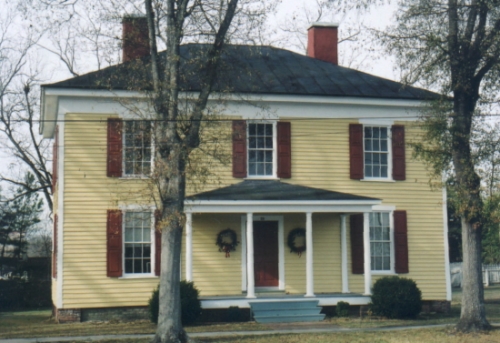
 |
|
Although a precise construction date for the (former) Baptist Parsonage has not
been determined, it seems likely that the house was built shortly after the
construction of the Kinston Baptist Church, which was dedicated in January
1858. The church originally stood on the northwest corner of Bright and
McLewean streets, and the parsonage was built at the rear (north end) of the
church lot. The two story frame residence is a relatively simple example of
mid-l9th century Greek Revival residential construction.
Dr. J. D. Hufham, the first pastor of the Kinston Baptist church, was probably the initial occupant of the house. The dwelling continued in use as the Baptist parsonage until December 1890 when grocer J. F. Stroud purchased the house from the church trustees for one thousand dollars. This sale occurred shortly before the church building was moved to a new location on the corner of Gordon and McLewean streets three blocks north of the original site. (The first church lot subsequently was subdivided and redeveloped). The Strouds sold the former parsonage to Lillie Archbell in June 1895 for fifty dollars more than their purchase price. Lillie Vause Whitehurst (later Archbell) had come to Kinston as a child of eight when her family fled the Union occupation of New Bern in 1862; they took refuge in the Kinston home of her aunt, Harriet Peebles Mrs. Peebles lived in the house now known as Harmony Hall, which is adjacent to the (former) Baptist Parsonage. Lillie Whitehurst was educated in Raleigh and returned to Kinston to teach in the free school. She married Henry Archbell in 1884, but continued to teach, operating a private school in their home. She was also active in the Kinston Baptist Church where she organized both the choir and the Sunbeams, a children's group. Henry Archbell was a native of Beaufort County who moved to Lenoir County in 1875, first operating as a retail grocer. Five years later, in 1880, he opened a candy factory on a small scale. By 1885, he was said to occupy "...the largest premises on the main Street' (Queen Street), selling candy, baked goods, tobacco products, ice cream, meals and sodas", in later years he was district representative for the National Biscuit Company. Lillie Archbell retained vivid childhood memories of the Civil War, and she felt compelled to compile her reminiscences with those of others so they would not be lost but would supplement other written accounts of the war. Dedicating it to "...our busy people who always have time to make history but never have time for research..." Mrs. Archbell became the editor, publisher, printer and solicitor of subscriptions for the seventeen issues of Carolina and the Southern Cross which were published between November 1912 and August 1914. In the first issue, she stated her desire to sprinkle personal experiences, reminiscences, and anecdotes with truthful accounts of all battles, home life in the state, and biographies of state war leaders. It was the official magazine of the United Daughters of the Confederacy, of which Mrs. Archbell was a member, and, although not intended as a scholarly work, it gained recognition across the state for its record of life in North Carolina during the Civil War. During their occupancy of the former Baptist parsonage, the Archbells made a number of alterations to the house. Among these changes was the replacement of the original entrance-bay porch with one which was nearly full-facade; it seems likely that the supports for this new porch were classical columns. The house originally had a detached rear kitchen which was linked to the house by a narrow porch; the Archbell's joined the kitchen to the house and made other small additions to the rear. They may also have been responsible for replacing the original windows with two over two sash and for a few interior alterations, as well. Since the recent rehabilitation of the house, little survives as evidence of the alterations made by the Archbells and later owners. The Archbells moved from Kinston to West Virginia in the early 1920s to live with their daughter, Mrs. Fred Dyer. It is unclear who occupied the house after this move. Henry Archbell died at his daughter's home in August 1927, and his body was returned to Kinston for a funeral service at First Baptist Church and burial at Maplewood Cemetery. His pallbearers included many of Kinston s most prominent businessmen, among them J. A. McDaniel, J.M.Quinn, C. Oettinger and W. D. LaRoque. Mrs. Archbell survived her husband by nearly twenty years, dying in Bristol, Virginia, at the age of 92. She also was interred at Maplewood Cemetery after services at First Baptist Church. About six months after her husband's death, Mrs. Archbell executed a deed of trust on the property to Wayne National Bank of Goldsboro; at a foreclosure sale in 1933, the house was purchased by Marion Oettinger. At some point during the 1920s or l930s, the classical porch columns added by the Archbells were replaced with the tapered posts on brick piers typical of the period. Frank Noble acquired the house in 1939; during his ownership, Noble converted the house to three units, adding two doors to the first floor facade and more wings on the rear. The Lenoir County Historical Association acquired the house in 1979 and has undertaken efforts to return the house to its presumed original appearance. This group removed the kitchen and other, later, rear wings, which were in deteriorated condition. They also replaced the early 20th century porch with an entrance-bay portico supported by classical columns, put six over six sash in most windows and restored the interiors first floor. |